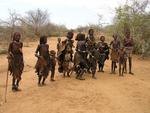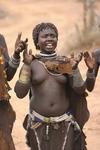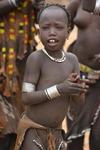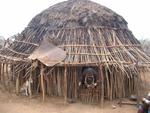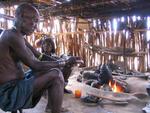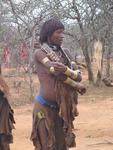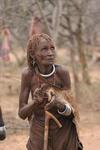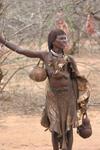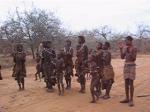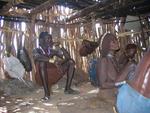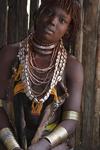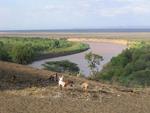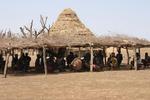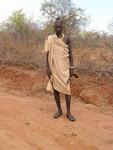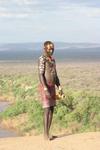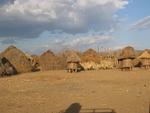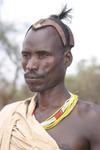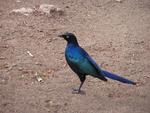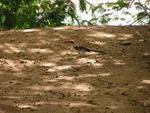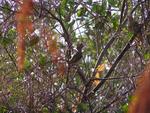The first destination for the day was a Hamer village but before
reaching the village, we stopped on the route to see some Hamer
dancing. A group where waiting on the road for us and Firew decided
it would be a good time to stop. This was one of the definitely
in Africa times. About ten women were dancing and some young boys.
One woman, a slightly dumpy, shorter woman was clearly their
leader and a voice for getting as much money as possible. At the
other end an old, blind woman was doing her best to dance and
clap in time. As they danced, they would bang their large, heavy
metal anklets together and rub one arm against the other to
make a washboard sound with their numerous bracelets. The young boys
clapped along but don't wear the same jewellery. Dogs watched
the dancing excitedly with blood splattered on their noses. They
were present because before our arrival, the woman had been hanging
meat for draining and drying in the trees.
The village stop was the last in Hamer territory. Although looking
quite basic, the huts were quie comfortable inside. Getting into them
proved quite difficult becuase of the very low and small doorway. I
was worried that I would end up carrying the hut away on my back. An
interesting part of the hut was the floor. The floor was made of
compacted and shaped mud. Shapes existed for seats and cooking
utensils. The carabashes (large rounded bowls) would be placed in
special indentations when being used so that they did not fall over.
When they were not being used, they would be hung on the wall.
The man of the hut had come in with us and was happy to show us his
family. He had five children from one wife and one from another.
One of his wives was showing us how to cook coffee in the Hamer style.
Once cooked, it would normally be served in to carabashes - one for
men only and one for women only.
After the Hamer village, our next destination was a the campsite at
Murelle. We
stopped off in a dry river bed for lunch. Afterneath a tree
sticks were arranged in a tee-pee like structure. Firew didn't
know why so we could only speculate why. The river bed was heavy
dust. Holes had been cut into it for watering holes but currently
they were empty. Steep sides with trees with dull green leaves and
grey trunks frames the rived bed. There seemed to be many
interesting stones and pyrite. Ethiopia is known as an interesting
place for geologists. A slightly less pleasant sight was a dead
baboon I found clinging to what would at some time be the
bank of the river. The carcus had been mummified by the dry heat.
The remaining drive to the campsite was difficult. It is fair to say
that there was no road. The drivers navigated around bushes and
trees, though the sand. At some points we needed to walk to make the
cars light enough to cope easily. When we were inside the cars, the
handles became vital to stop you from smashing your brains out
as you were thrown from one side of the car to the other.
The Murelle campsite appears to be more like a hunting lodge. Around
the place that we pitched the tent were large concrete appartment
buildings. It would have cost USD120 per night to stay in them. They
seemed quite basic but this was another 'arse end of nowhere' place.
Hence, they could charge the price they wanted. In addition, due to
the difficulty of getting supplies to this place they wouldn't sell
any drinks to mere campers.
The campsite overlooked the Omo river. While Firew arranged things
we stood looking down onto the river through large green trees hiding
Colobus monkeys.
Our stop for that afternoon was a Karo village. This is a different
tribe to the Hamer with quite a different lifestyle. When you read
or are told about the Karo, one thing that you are often told about
is the fact that they do not have a word for thief. Pilfering is
part of their way of life. They are thieves. By extension I reckon
that they do actually have a word for thief - it's Karo. The
village was only 5km away but Firew was not happy with the suggestion
that we walk it.
The village had a magnificient view of the Omo river. The people were
quite 'in your face' and the hassle level was quite high. They were
also asking for two birr per photo continually so I just put the
camera away. Much of the time, a large, well built man was holding
my hand. The physique of people in this region is very different
to Tigray. Tigrayan men are slight of build and delicate. Men here
are much stronger and broader chested. Physical prowess is much
more important here. The symbol for a warrior in a Karo tribe
is a feather attached to the warriors head. It is held in place by mud
shaped around the hair. It is very important for them to preserve
this so they have a stool for both sitting on and using as a pillow
when they sleep. Their head never touches the ground. In order to
claim your feather you need to have killed a dangerous animal or
an enemy. The number of dangerous animals has dropped so they have
taken to killing Hamer people for their feather. This doesn't
really seem fair because the Hamer people are much more peaceful and
I think classing them as enemy just for the sake of a feather
is going too far.
In the meantime, Terri was learning some Karo (she can count to ten)
and looking for her husband. We had all been prepped for this.
In the Bradt guide there is a photo of a Karo man with two feathers
and body painting. She told her mum that she was going to marry
this man. So, we were looking for him. We asked at the village if
they knew the man and they said that he was at another village
not far away. Firew adjusted the itinary to include a trip to another
Karo village on the following day.
It is common for people to ask you to give them things. What was new
for me was that they were asking for soap. After our failure to
find Terri's husband we were quite relieved to get back into the
cars and head to the campsite. Getting in the cars, everybody checked
that they had everything that they came with.
Back at the campsite we did some washing using the brown water from
the Omo. We didn't go down to the river edge. Although we could
not see them we had been told that there were crocodiles in this part
of the river. Instead, a convenient tap provided water pumped up
from the river. The same brown water could be found in the showers
but they were lovely.
Murelle seemed to be a good place for looking at animals although
the monkeys were rather shy. Flocks of glossy starlings, woodpeckers
and cockatoo like birds were common. We had pitched the tents
without flysheets because of the heat. We were quite surprised when
it started to rain. The rain was only a light shower but it
just seemed so out of place.
